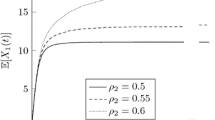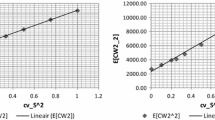Abstract
A new approach is developed for the joint queue-length distribution of the two-level non-pre-emptive M/M/c (i.e. Markovian) priority queue that allows explicit and exact results to be obtained. Marginal distributions are derived for the general multi-level problem. The results are based on a representation of the joint queue-length probability mass function as a single-variable complex contour integral, which reduces to a real integral on a finite interval arising from a cut on the real axis. Both numerical quadrature rules and exact finite sums, involving Legendre polynomials and their generalization, are presented for the joint and marginal distributions. A high level of accuracy is demonstrated across the entire ergodic region. Relationships are established with the waiting-time distributions. Asymptotic behaviour in the large queue-length regime is extracted.








Similar content being viewed by others
Notes
The symbol r is reserved for the two-level problem. For the two-level problem (\(K = 2\)), \(r_{\text {agg}} = r\).
All computation is performed in Matlab R2020a, which implements IEEE Standard 754 for double precision.
References
Cohen, J.W.: Certain delay problems for a full availability trunk group loaded by two traffic sources. Philips Telecommun. Rev. 16(3), 105–113 (1956)
Almehdawe, E., Jewkes, B., He, Q.-M.: A Markovian queueing model for ambulance offload delays. Eur. J. Oper. Res. 226(3), 602–614 (2013)
Hou, J., Zhao, X.: Using a priority queueing approach to improve emergency department performance. J. Manag. Anal. 7(1), 28–43 (2020)
Taylor, I.D.S., Templeton, J.G.C.: Waiting time in a multi-server cutoff-priority queue, and its application to an urban ambulance service. Oper. Res. 28(5), 1168–1188 (1980)
Orman, A.J.: Models for scheduling a multifunction phased array radar system. Ph.D. thesis, University of Southampton, Southampton, UK (1995)
Orman, A.J., Potts, C.N., Shahani, A.K., Moore, A.R.: Scheduling for a multifunction phased array radar system. Eur. J. Oper. Res. 90(1), 13–25 (1996)
Pestalozzi, G.: Priority rules for runway use. Oper. Res. 12(6), 941–950 (1964)
Zuk, J., Kirszenblat, D.: Explicit results for the distributions of queue lengths for a non-preemptive two-level priority queue. Submitted to Ann. Oper. Res. (2023). https://doi.org/10.2139/ssrn.4574550
Sleptchenko, A.: Multi-class, multi-server, queues with non-preemptive priorities. Report Eurandom Vol. 2003016, EURANDOM, Eindhoven University of Technology, The Netherlands (2003). https://pure.tue.nl/ws/portalfiles/portal/3290904/567759.pdf
Li, H., Zhao, Y.Q.: Exact tail asymptotics in a priority queue—characterizations of the non-preemptive model. Queueing Syst. 68(2), 165–192 (2011)
Zuk, J., Kirszenblat, D.: Joint queue-length distribution for the non-preemptive multi-server multi-level markovian priority queue. Submitted to 4OR (2023). https://doi.org/10.2139/ssrn.4621771
Karlin, S., McGregor, J.L.: Many server queueing processes with Poisson input and exponential service times. Pac. J. Math. 8(1), 87–118 (1958)
Zuk, J., Kirszenblat, D.: Exact results for the distribution of the partial busy period for a multi-server queue. Queueing Syst. (2024). https://doi.org/10.2139/ssrn.4569933
Davis, R.H.: Waiting time distribution of a multi-server, priority queuing system. Oper. Res. 14(1), 133–136 (1966)
Bertsimas, D., Mourtzinou, G.: Multiclass queueing systems in heavy traffic: An asymptotic approach based on distributional and conservation laws. Oper. Res. 45(3), 470–487 (1997)
Zuk, J., Kirszenblat, D.: A queueing model for the ambulance ram** problem with an offload zone. Submitted to Eur. J. Oper. Res. (2024). https://doi.org/10.2139/ssrn.4692322
Shortle, J.F., Thompson, J.M., Gross, D., Harris, C.M.: Fundamentals of Queueing Theory, 5th edn. Wiley, Hoboken (2018)
Gail, H.R., Hantler, S.L., Taylor, B.A.: Analysis of non-preemptive priority multi-server queue. Adv. Appl. Probab. 20(4), 852–879 (1988)
Kao, E.P.C., Narayanan, K.S.: Computing steady state probabilities of a non-preemptive priority queue. INFORMS J. Comput. 2(3), 211–218 (1990)
Gnedenko, B.V., Kovalenko, I.N.: Introduction to Queueing Theory, 2nd edn. Birkhäuser, Boston (1989)
Flajolet, P., Sedgewick, R.: Analytic Combinatorics. Cambridge University Press, New York (2009)
Picard, E.: Sur une extension aux fonctions de deux variables du problème de Riemann relatif aux fonctions hypergéométriques. Annales Scientifiques de l’École Normale Supérieure, Serie 2(10), 305–322 (1881)
Gradshteyn, I.S., Ryzhik, I.M.: Table of Integrals, Series, and Products, 7th edn. Academic Press, Burlington (2007)
Gautschi, W.: Orthogonal Polynomials: Computation and Approximation, 1st edn. Oxford University Press, Oxford (2004)
Gautschi, W.: Orthogonal polynomials (in Matlab). J. Comput. Appl. Math. 178(1), 425–434 (2005)
Chawla, M.M.: Estimation of errors of Gauss–Chebyshev quadratures. Comput. J. 13(1), 107–109 (1970)
Rice, S.O.: Distribution of quadratic forms in normal random variables—evaluation by numerical integration. SIAM J. Sci. Stat. Comput. 1(4), 438–448 (1980)
Press, W.H., Teukolsky, S.A., Vetterling, W.T., Flannery, B.P.: Numerical Recipes: The Art of Scientific Computing, 3rd edn. Cambridge University Press, Cambridge (2007)
Trefethen, L.N., Weideman, J.A.C.: The exponentially convergent trapezoidal rule. SIAM Rev. 56(3), 385–458 (2014)
Bertsimas, D., Nakazato, D.: The distributional Little’s law and its applications. Oper. Res. 43(2), 298–310 (1995)
Keilson, J., Servi, L.D.: A distributional form of Little’s law. Oper. Res. Lett. 7(5), 223–227 (1988)
Erdélyi, A.: Some confluent hypergeometric functions of two variables. Proc. R. Soc. Edinb. 60(3), 344–361 (1940)
Gautschi, W.: Gauss quadrature approximations to hypergeometric functions and confluent hypergeometric functions. J. Comput. Appl. Math. 139(1), 173–187 (2002)
Abate, J., Whitt, W.: Asymptotics for M/G/\(1\) low-priority waiting-time tail probabilities. Queueing Syst. 25, 173–233 (1997)
Kella, O., Yechiali, U.: Waiting times in the non-preemptive priority M/M/\(c\) queue. Commun. Stat. Stochast. Models 1(2), 257–262 (1985)
Holley, J.L.: Waiting line subject to priorities. Oper. Res. 2(3), 341–343 (1954)
Li, Y.T., Wong, R.: Integral and series representations of the Dirac delta function. Commun. Pure Appl. Anal. 7(2), 229–247 (2008)
Acknowledgements
The authors gratefully acknowledge useful discussions with Dr. Stephen Bocquet.
Author information
Authors and Affiliations
Corresponding author
Additional information
Publisher's Note
Springer Nature remains neutral with regard to jurisdictional claims in published maps and institutional affiliations.
Appendices
Appendix A Joint asymptotics
To determine the large-\(\ell \) behaviour of the joint integral (89), we use the symmetry properties and periodicity of the integrand to write it as an integral over the interval \(\theta \in [0,2\pi )\). We then promote the integration variable \(\theta \) to the complex plane and deform the contour from \(\theta = 0\) to \(\theta = 2\pi \) into three straight legs: (i) from 0 to \(0 + i\infty \), (ii) from \(0 + i\infty \) to \(2\pi + i\infty \), and (iii) from \(2\pi + i\infty \) to \(2\pi \), making small excursions on the vertical legs around the points \(\theta = \, \textrm{acos}(\alpha ), \, \textrm{acos}(\beta )\). The contribution from the horizontal contour vanishes, while the vertical contours cancel apart from the excursions around the singular points. As a result, we obtain the decomposition \(J_{\text {scl}}(\ell ,m) = J_{\text {scl}}^\alpha (\ell ,m) + J_{\text {scl}}^\beta (\ell ,m)\) where, on writing \(\theta = it\), we have
where \(C_\alpha \) is an infinitesimal anti-clockwise circle about the point \(t = {{\,\textrm{acosh}\,}}(\alpha )\), and likewise for \(C_\beta \) about the point \(t = {{\,\textrm{acosh}\,}}(\beta )\).
It is clear that \(J_{\text {scl}}^\beta (\ell ,m) = d_{\ell +1}(\beta )\). To evaluate \(J_{\text {scl}}^\alpha (\ell ,m)\), we set \(\alpha \equiv \cosh (s)\) so that
Taking the limit yields
where \(\mathcal {C}_0\) is an infinitesimal anti-clockwise circle about the origin. The result (123) in the main text follows. To see how to use it in determining the asymptotics of the joint PMF, let us make the decomposition \(P_{\text {cut}}(\ell ,m) = P^{\alpha }(\ell ,m) + P^{\beta }(\ell ,m)\), where \(P^{\alpha }(\ell ,m)\) denotes the component of the cut contribution to the joint PMF that arises solely from \(J_{\text {scl}}^{\alpha }(\ell ,m)\), and where \(P^{\beta }(\ell ,m)\) arises solely from \(J_{\text {scl}}^{\beta }(\ell ,m)\). One can show that the \(\beta \)-component exactly cancels the pole term, \(P^{\beta }(\ell ,m) = -P_{\text {pol}} (\ell ,m)\), which leads to the representation
It is straightforward to evaluate \(J_{\text {scl}}^\alpha (\ell ,m)\) for \(m = 0\) and confirm that the expected result for \(P_{\text {xhi}}(\ell ) = P(\ell ,0)\) is recovered. We obtain \(P_{\text {xhi}}(\ell ) = (1-r)r_{\text {hi}}^{\ell /2}{\cdot }d_\ell (\alpha )\) which, given (49) and (109), reproduces the form cited above (120). A by-product of this discussion is an alternative representation of the joint integral, given by
The large-m asymptotics for fixed \(\ell \) follow directly from (81) as
where the asymptotics of the integral follow from (64) and (68) for non-vanishing and vanishing values of b, respectively. The results obtained here are consistent with those presented in [10], when specialized to the case of a common service rate.
Appendix B Laguerre series for the waiting time
Let us write \(p_n \equiv P_\mathscr {L}(n)\) so that
where the closed anti-clockwise traversed integration contour \(\mathcal {C}\), initially taken to be a circle centred on the origin of radius \(0< \eta < 1/r\), is deformed into the Bromwich contour \(\Gamma \) on which \(z = \delta +iy\) with \(-\infty< y < +\infty \), for some \(1< \delta < 1/r\) so that \(\mathop {\textrm{Re}} \nolimits z > 1\). Then, we consider the Binomial transform of the \(p_n\) sequence
We now recall the generating function for the Laguerre polynomials \(L_n(x)\), given by
On setting \(\tau = 1 - 1/z\) and \(x = r_{\text {lo}}t\), this reads
from which it follows that
Now, (125) can be written as
where \(t' = r_{\text {lo}}t\) and \(P'_\mathscr {W}(t')dt' = P_\mathscr {W}(t)dt\). We also have
These may be combined to yield
The completeness relation [37]
\(\delta (t)\) being the Dirac delta function, implies the convergent Laguerre-series representation
and we conclude, via (B11), that
The Bromwich contour \(\Gamma \), with \(\Re z > 1\), may now be deformed as \(\Gamma \mapsto \mathcal {C}_{\text {pol}} \cup \mathcal {C}_{\text {cut}}\) so that it wraps around the pole and cut of \(g_{\text {lo}}(z)\). This serves to reproduce (130).
The convergence claim for (B16) follows from the theorem that the formal expansion
converges in \(L_2\) if and only if \(\Vert \gamma \Vert ^2_{L_2} < \infty \), where
In the present application, we have \(\gamma (t) = P'_{\mathscr {W}}(t)\) for which, trivially,
One should note that, while the coefficients \(\gamma _n\) of the Laguerre series (B16) are constructed as (potentially) numerically problematic alternating combinatorial sums, the last equality in (B8) shows that they can be efficiently computed by means of the very same iterative quadrature method derived for the queue-length probabilities \(p_n\). Explicitly,
where \(c \equiv (x_- - 1)/x_{\text {dif}} = (1-r)a + rb\).
Rights and permissions
About this article
Cite this article
Zuk, J., Kirszenblat, D. Analytic approach to the non-pre-emptive Markovian priority queue. Queueing Syst 107, 159–198 (2024). https://doi.org/10.1007/s11134-024-09912-3
Received:
Revised:
Accepted:
Published:
Issue Date:
DOI: https://doi.org/10.1007/s11134-024-09912-3




